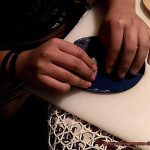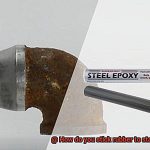Welcome to our blog post all about tackling the tough task of removing hardened glue from plastic.
We know firsthand how infuriating it can be when that sticky residue just won’t budge from your beloved plastic items. But fret not, because we’ve got the perfect solution for you.
In this post, we’ll walk you through a step-by-step guide on how to effectively banish hardened glue from any plastic surface. Whether it’s stubborn superglue clinging onto your favorite toy or adhesive remnants marring the beauty of your phone case, we’ve got your back.
So grab your trusty tools and get ready to dive headfirst into the wonderful world of safe, easy, and reliable glue removal methods.
Understanding the Nature of Glue and Plastic
Contents
Glue, that sticky substance we rely on to bond objects together, comes in various forms such as liquid, gel, or solid. It is commonly made from synthetic materials like polymers or natural substances like animal collagen. Its purpose is to create a strong adhesive bond between surfaces, ensuring they stick together securely.
In the market, there are numerous types of glue available, each designed for specific purposes. Super glue, epoxy glue, craft glue, and hot glue are just a few examples. These different types have unique properties and strengths, making them suitable for bonding different materials and applications.
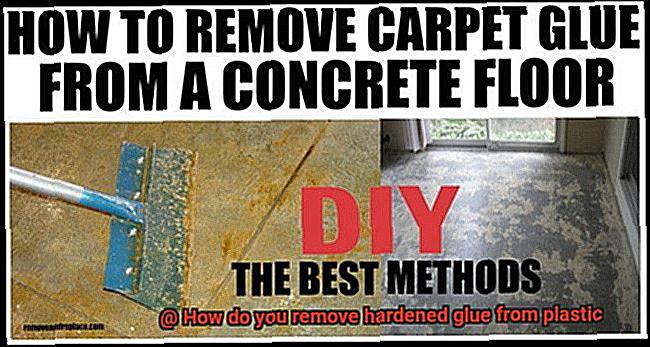
Plastic, on the other hand, is a versatile material widely used in various industries due to its durability, flexibility, and cost-effectiveness. It can be found in everyday items such as toys, containers, electronics, and household appliances. Plastic comes in different forms like polyethylene, polypropylene, PVC, and PET, each with its own distinct properties.
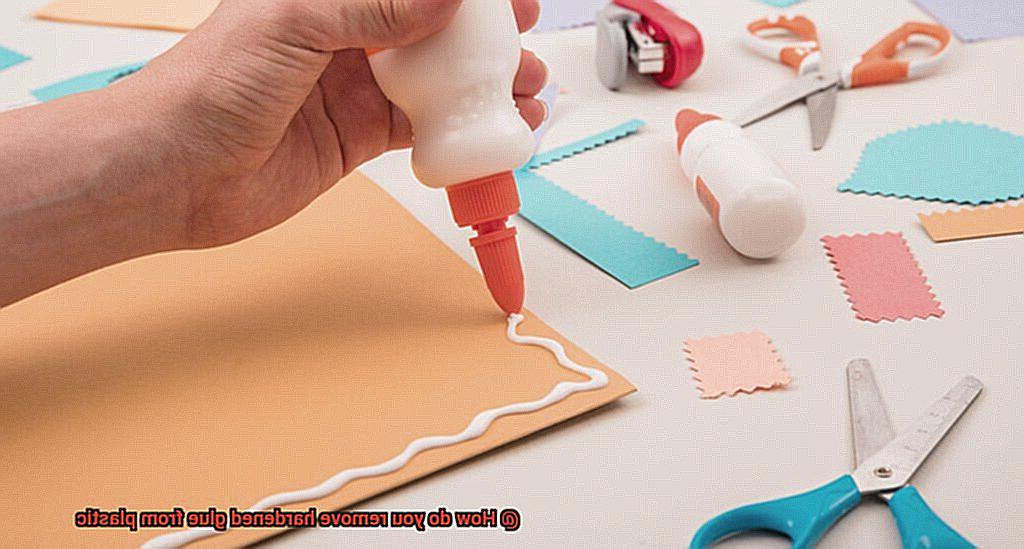
When glue comes into contact with plastic surfaces, it chemically adheres to the surface molecules to form a bond. However, the effectiveness of this bond depends on factors such as the type of glue used, the type of plastic involved, and the surface preparation done prior to bonding. Some glues may not bond well with certain types of plastics, leading to weak or no adhesion at all.
Removing hardened glue from plastic surfaces presents a challenge. Over time, glue can dry and form a hardened layer due to exposure to air or moisture. This hardened glue can be difficult to remove without proper techniques.
There are several methods for removing hardened glue from plastic surfaces. These include using solvents like acetone or rubbing alcohol, applying heat through a hairdryer or warm water, using mechanical methods like scraping or sanding, or utilizing specialized glue removers available in the market. It is important to choose the most suitable method based on the type of glue and plastic being dealt with.
Using Solvents to Remove Glue
Removing stubborn glue from plastic surfaces can be a daunting task, but fear not. Solvents are here to save the day. Among the arsenal of solvents, acetone reigns supreme as a tried and tested solution for dissolving various adhesives. It’s like a superhero swooping in to rescue your plastic from the clutches of hardened glue.
Before unleashing the power of acetone or any solvent, it’s crucial to tread cautiously. Test it on a discreet area of the plastic to ensure that no damage or unsightly discoloration occurs. We don’t want any unintended casualties in this battle against glue.
To wield the power of acetone, arm yourself with a clean cloth or cotton ball soaked in the solvent. Gently massage the cloth over the hardened glue, allowing the acetone to seep into its adhesive heart and soften it. Patience is key here, my friend. Let it sit for a few minutes, allowing the solvent to work its magic. Once the glue has surrendered and softened, carefully peel it off using either a plastic scraper or your nimble fingers. But be gentle. We don’t want to leave any battle scars on our plastic surface.
Now, what if acetone is nowhere to be found? Fear not, for there are other valiant solvents ready to join the fight against glue. Rubbing alcohol, nail polish remover (the ones containing acetone), WD-40, and even trusty vegetable oil are all formidable contenders. Just apply one of these solvents onto a clean cloth and follow the same steps as you would with acetone.
But remember, dear warrior, safety first. Always work in a well-ventilated area and shield your delicate skin and eyes from any solvent encounters. Don your gloves and protective eyewear if needed.
Once you’ve triumphantly banished the glue using your chosen solvent, don’t forget to restore order by cleaning the plastic surface with warm soapy water. This will ensure that no residue remains to haunt your freshly liberated plastic. And, of course, dry the surface thoroughly before putting it back into action or storing it away.
Now, fair warning, my fellow adventurer: some glues may prove more resilient against solvents. If you find yourself facing such a formidable opponent, don’t hesitate to seek guidance from a professional or reach out to the adhesive’s manufacturer for specialized strategies.
Applying Heat to Soften Glue
I am here to share a secret weapon that will soften that adhesive and make it a breeze to remove. The key to this battle is heat, my friends.
Applying heat is a tried and true method for breaking down the chemical bonds in glue, making it more pliable and easier to scrape off. But how exactly can you harness the power of heat to conquer that pesky glue?
One popular method is using a hairdryer or a heat gun. Picture this: you direct the hot air onto the glue, like a superhero wielding their mighty blowtorch. But beware. Just as a superhero must exercise caution, it is important not to use excessive heat that could damage the plastic. Start with low heat, like a gentle whisper, and gradually increase if necessary. As the glue softens under the spell of warmth, you can then don your trusty plastic scraper or even a credit card to gently scrape away the softened adhesive.
Another method involves the enchanting powers of hot water. For larger plastic objects in need of liberation, immerse them in a bath of hot water for a few minutes until the glue begins to surrender its grip. Then, armed with a soft cloth or sponge, gracefully rub away the softened adhesive – no spells required. If you find yourself dealing with smaller objects, summon boiling water to pour over them and watch as the glue succumbs to its liquid adversary. Afterward, seize your toothbrush or small brush and unleash your scrubbing prowess upon the softened adhesive.
However, it is crucial to note that not all plastics are created equal. Some types, like PVC or polystyrene, quiver at the sight of high temperatures and may melt or deform under such conditions. To avoid any spellbinding mishaps, always test a small inconspicuous area first before applying heat to the entire surface.
Lastly, remember to channel your inner sorcerer and work in a well-ventilated area when using heat on adhesives. Proper ventilation is essential to avoid inhaling any fumes that may accompany your enchanting endeavors. If necessary, consider donning a respirator for added protection – after all, even the most skilled sorcerers take precautions.
Once you have successfully banished the softened glue, do not forget to cleanse the plastic surface with mild soap and water to rid it of any lingering residue. And if you encounter stubborn glue that refuses to yield, do not despair. Sometimes, these adhesives possess an unwavering resilience that requires multiple attempts or additional methods for complete removal.
Utilizing Mechanical Methods
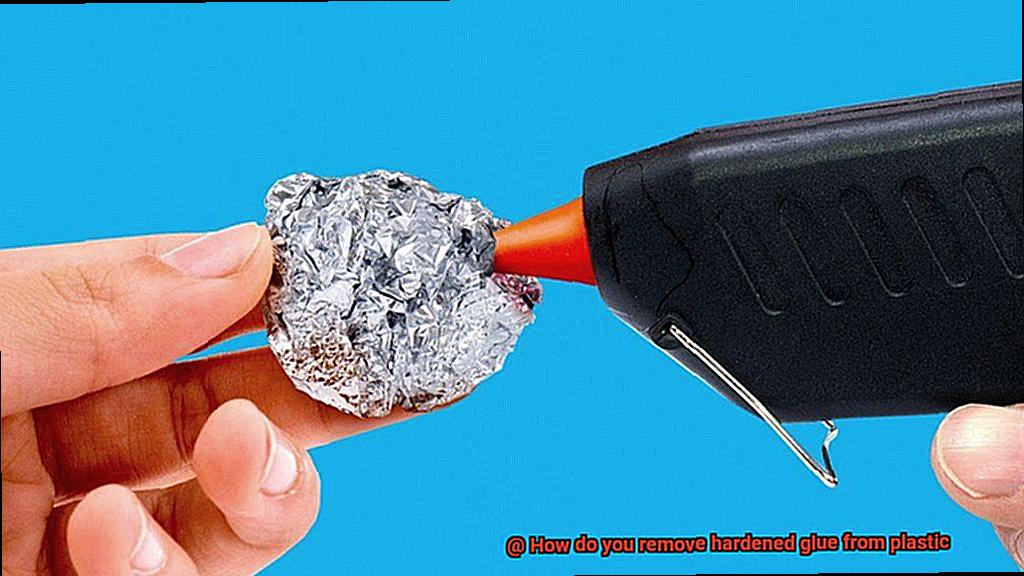
Utilizing mechanical methods is like unleashing a sturdy army to combat the stubborn enemy that is hardened glue on plastic surfaces. These methods involve the physical manipulation of tools and techniques to scrape or peel off the glue, resulting in a triumphant victory of restored plastic surfaces.
One powerful warrior in this battle is the plastic scraper or putty knife. With their flat, smooth edges, these tools delicately wield their might, skillfully removing the glue without inflicting any wounds upon the plastic surface. Employing controlled movements and gentle force, they ensure that scratches and marks remain mere legends of battles past.
Another technique in this arsenal is the art of peeling by hand. The glues that have not fully embraced their plastic hosts can be easily coerced into submission. Armed with nothing but a fingernail or a blunt object like a credit card, you can embark on a journey of liberation. Begin by lifting a corner of the glue and gradually apply steady pressure as you peel it off, being cautious not to exert excessive force.
The element of heat adds an incendiary advantage to this battle. It softens the glue, making it more amenable to scraping or peeling. The hairdryer takes center stage, its lowest heat setting exuding gentle warmth upon the glue. As you wield this weapon, keep it a few inches away from the glued area and move it back and forth until you notice the glue’s surrender, becoming pliable and ready for removal. Then, seize your plastic scraper or utilize your fingers to gently eradicate the softened adhesive.
For those relentless foes that refuse to yield, solvents and adhesive removers step onto the battlefield with specialized prowess. Gels, liquids, or sprays, these products are specifically designed to conquer glue residue. However, caution must be exercised. Before launching an all-out assault on the entire glue-affected area, diligently test the solvent on a small corner of the plastic surface, ensuring that it does not deface or discolor the material.
A Gentle Approach for Delicate Plastics
When it comes to delicate plastics, a gentle approach is crucial for removing hardened glue without causing any damage. These materials can easily be scratched or discolored, so it is important to use methods that are effective yet safe. Here are some tips on how to remove hardened glue from delicate plastics using gentle methods:
- Soak in Warm, Soapy Water: Start by soaking the plastic in warm water mixed with a mild soap for a few minutes. This will help soften the glue and make it easier to remove. Be sure to use only lukewarm water, as hot water can warp or melt the plastic.
- Gently Scrub with a Soft-Bristled Toothbrush or Sponge: After soaking, gently scrub the glue using a soft-bristled toothbrush or sponge. Apply light pressure and circular motions to prevent scratching the plastic surface. If the glue is stubborn, you can repeat the soaking process and continue scrubbing until it comes off.
- Use Plastic Scraper or Credit Card: If the glue doesn’t come off easily with scrubbing, you can try using a plastic scraper or a credit card. Gently scrape away the hardened glue, taking your time and being careful not to apply too much pressure. This method is particularly useful for larger areas or thicker layers of glue.
- Try Rubbing Alcohol or Acetone: Another gentle approach is to use rubbing alcohol or acetone. These substances can help dissolve the glue without damaging the plastic surface. Apply a small amount of alcohol or acetone to a cotton ball or soft cloth and gently rub the glue until it starts to come off. Remember to test a small, inconspicuous area of the plastic first to ensure it won’t get damaged by these substances.
- Commercial Adhesive Removers: If other methods don’t work, there are commercial adhesive removers available specifically designed for removing glue from delicate plastics. Follow the instructions on the product carefully and use it sparingly to avoid any damage. Always test a small area first to ensure compatibility with the plastic.
- Rinse and Dry: After removing the hardened glue, rinse the plastic thoroughly with warm water and mild soap to remove any residue from the cleaning process. Finally, dry the plastic with a soft cloth or allow it to air dry. Avoid using heat sources such as hair dryers, as they can warp or melt delicate plastics.
Testing Beforehand
Testing beforehand is a critical step when it comes to removing hardened glue from plastic. It allows you to avoid potential damage to the plastic surface, identify the most effective removal method, test commercial adhesive removers, explore homemade remedies, and consider the impact on color and finish.
Different types of glues and plastics can react differently to removal methods. By conducting a test beforehand, you can assess whether the chosen method will cause any damage or discoloration to the plastic surface. This is particularly important when dealing with delicate or valuable items that require extra care.
Furthermore, there are various types of glues available, each requiring a different approach for removal. By testing different methods on a small inconspicuous area, you can determine which one works best for the specific type of glue on your plastic item. This saves time and effort by avoiding potentially ineffective methods.
If you decide to use a commercial adhesive remover, it is essential to follow the manufacturer’s instructions. Testing on a small area first allows you to identify any adverse reactions and ensures that the product is safe to use on a larger section. This step is particularly important if the adhesive remover contains harsh chemicals that could potentially damage the plastic.
In addition to commercial adhesive removers, some homemade remedies like rubbing alcohol or acetone are commonly suggested for removing certain types of glues from plastic surfaces. However, it’s important to remember that these substances can also cause damage to certain types of plastics. Conducting a small test patch will help determine if these remedies are suitable for your specific plastic material.
Lastly, it is crucial to consider the color and finish of the plastic item during testing. Different plastics have different colors and finishes, and some solvents or products may cause discoloration or dulling. By testing beforehand, you can check for any unwanted changes in appearance and ensure that the glue removal method does not compromise the aesthetic appeal of the plastic item.
Cleaning and Drying After Removal
Cleaning and drying after removal is an essential step to ensure that no residue or moisture remains on the plastic surface, which could impact its appearance or functionality. Here are some effective methods and tips to follow:
- Warm soapy water: Fill a basin or sink with warm water and add a few drops of mild dish soap. Gently scrub the plastic surface with a soft cloth or sponge, paying close attention to any areas where glue residue may still be present. Rinse thoroughly with clean water to remove any soap residue.
- Rubbing alcohol: Moisten a cloth or cotton ball with rubbing alcohol and gently wipe away any remaining adhesive residue. Test a small, inconspicuous area first before using it on the entire surface to prevent damage.
- Specialized cleaners: For stubborn glue residue, consider using acetone found in nail polish remover. However, be cautious as acetone can damage or discolor certain types of plastics. Always check the manufacturer’s recommendations before using acetone.
- Thorough drying: After removing adhesive residue, thoroughly dry the plastic surface to prevent mold or mildew growth. Use a clean, dry cloth to remove excess water and allow the plastic to air dry completely before storing or using it again.
- Hairdryer for larger items: For larger plastic items that are not easily dried by hand, use a hairdryer on a low heat setting to speed up the drying process. Keep the hairdryer at a safe distance from the plastic to prevent overheating or damage.
Remember to refer to the manufacturer’s recommendations or seek professional advice for specific cleaning and drying techniques for different types of plastics.
Exercising Caution During Removal
Exercising caution during the removal of hardened glue from plastic is crucial to avoid causing damage to the plastic surface. Before attempting any removal method, it is important to assess the type of plastic and the nature of the glue. Different plastics may react differently to certain solvents or cleaning agents, so it is essential to choose a method that is safe and effective for the specific type of plastic.
One important precaution to take is to test any cleaning agent or solvent on a small, inconspicuous area of the plastic before applying it to the entire surface. This will help determine if there are any adverse reactions, such as discoloration or damage. It is also advisable to wear protective gloves and work in a well-ventilated area to avoid inhaling any fumes or getting the cleaning agent on your skin.
When attempting to remove hardened glue, it is best to start with gentle methods before resorting to more aggressive ones. One common approach is to use warm, soapy water and a soft cloth or sponge. Gently rub the glue in circular motions until it starts to loosen. If this method proves ineffective, there are other options to consider.
For certain types of glues, such as super glue or epoxy, acetone can be an effective solution. However, not all plastics are compatible with acetone, so it is important to check if the plastic can withstand this solvent. Acetone should be applied sparingly using a clean cloth or cotton swab, focusing only on the area where the glue is present. It is vital to avoid letting acetone sit on the plastic for an extended period as it may cause damage.
In some cases, using heat can help soften hardened glue and make it easier to remove. This can be done by using a hairdryer on a low setting and directing the warm air towards the glued area. The heat should be applied from a safe distance and moved around continuously to prevent overheating or melting the plastic. Once the glue begins to soften, it can be gently scraped off with a plastic scraper or a credit card.
If the above methods do not work or are not suitable for the specific type of glue and plastic, there are commercial adhesive removers available on the market. These products are designed to dissolve and remove various types of adhesives without causing damage to the plastic surface. It is important to carefully read and follow the instructions provided by the manufacturer to ensure safe and effective use.
HWe-hGlwxiE” >
Also Read: How do you remove dried glue from rubber?
Conclusion
Removing hardened glue from plastic can be a challenging task, but fear not.
There are several effective methods that can help you restore your plastic items to their former glory. One option is to use acetone, a powerful solvent that can dissolve the glue and make it easier to remove.
Simply apply a small amount of acetone onto a cloth or cotton ball and gently rub the affected area until the glue starts to loosen. Another option is to use rubbing alcohol, which can also break down the adhesive properties of the glue.
Douse a cloth with some rubbing alcohol and gently scrub the hardened glue until it begins to soften. For more stubborn glue stains, you may need to employ the power of heat.
Using a hairdryer on its highest setting, direct hot air onto the glued area for a few minutes. This will soften the adhesive and allow you to scrape it off with a plastic scraper or your fingernail.
Remember to be cautious when using heat and always protect your hands with gloves. If all else fails, there are commercial adhesive removers available in stores that are specifically designed for removing hardened glue from plastic surfaces.
Whichever method you choose, always remember to test it on a small inconspicuous area first to ensure that it does not damage or discolor your plastic item.



